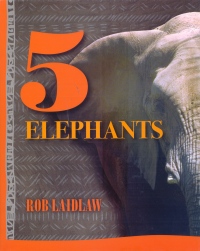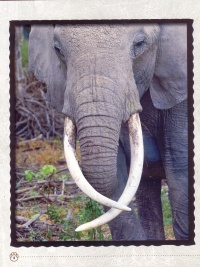| ________________
CM . . .
. Volume XXI Number 7. . . .October 17, 2014
excerpt:
Read any book about elephants, and you will learn remarkable details about their size, their physical adaptations, their intelligence and their special habitat needs. 5 Elephants merges that factual approach with something different: personal profiles of five elephants whose lives have intersected with humans, but not always in favorable ways. As well, the author delves deeply into the survival challenges facing the world’s remaining wild elephant populations. Laidlaw lends his expertise as founder of Zoocheck, an international wildlife protection organization, to this thoroughly researched presentation. He invites readers to become Elephant Guardians by practicing suggested protective measures such as boycotting ivory products and elephant performances, and to speak up for elephants, both in captivity and in the wild, through letter-writing or fundraising campaigns. An impressive list of Elephant-Welfare Organizations gives readers many options to learn more.
The third story features Tarra, captured to serve at first as a gimmick to attract customers to a tire dealership. While her later life included performing, her new caretaker provided exercise and good care, and Tarra eventually became the first resident of a new sanctuary in Tennessee, one of many such facilities that have sprung up around the world. The final story involves Thandora, relegated to a zoo in South Africa after her family was culled in Kruger National Park. Public pressure about her unsuitable living conditions resulted in Thandora being ‘rewilded’ – returned to the wild in Gondwana Game Reserve. Part of a special reintroduction project, this elephant became the model for other successful transitions of captive elephants into the wild. Together, these five stories focus on the rights of elephants to live safe happy lives and how public attitudes have evolved in this regard. Chapter 12 discusses the differences between captivity in a zoo as opposed to a sanctuary or rescue center, and, at various points in the book, Laidlaw devotes considerable space to explaining the tragic effects of the ivory trade on the world’s wild elephant population. Millions of the animals have been illegally poached for their tusks alone. The book describes some countries’ recent attempts to counter this situation by burning their stockpiles of ivory to discourage further hunting. The stories are written in an engaging style, and the alternate factual chapters address any questions that arise from them. Young animal lovers will see opportunities to become involved with wildlife conservation and protection activities to improve the plight of the world’s remaining elephants. Top quality photos help the reader gain insight into elephant lives and challenges and to feel empathy for these amazing animals. Highly Recommended. Gillian Richardson is a freelance writer living in BC.
To comment
on this title or this review, send mail to cm@umanitoba.ca.
Copyright © the Manitoba Library Association. Reproduction for personal
use is permitted only if this copyright notice is maintained. Any
other reproduction is prohibited without permission.
Next Review |
Table of Contents for This Issue
- October 17, 2014. |

 The stories of five individual elephants offer the reader a unique chance to understand how these animals function within their family groups, and what traumatic lives they endure when removed to unusual situations where they cannot exhibit normal, healthy behaviours. The first study follows the life of Echo living within Kenya’s Amboseli National Park as she becomes part of a long-running research project. Scientists learned a great deal about the lives and relationships of elephants, knowledge they have been able to apply to understanding the needs of elephants in captivity. Lucy, thought to have been orphaned in Sri Lanka, has spent a good deal of her life alone in a small Edmonton zoo, an unnatural state for a highly social animal. Her story is used to highlight the lack of physical and mental stimulation for captive elephants. Tusko was brought to the United States at age six to be a show animal, but he grew into a huge bull with naturally aggressive tendencies which led to a life in chains. It became impossible to find a place to contain him, and he died at age 42, never knowing freedom from pain and confinement. His story shines a light on ways elephants have been used as beasts of burden, war machines, religious symbols, and for human amusement.
The stories of five individual elephants offer the reader a unique chance to understand how these animals function within their family groups, and what traumatic lives they endure when removed to unusual situations where they cannot exhibit normal, healthy behaviours. The first study follows the life of Echo living within Kenya’s Amboseli National Park as she becomes part of a long-running research project. Scientists learned a great deal about the lives and relationships of elephants, knowledge they have been able to apply to understanding the needs of elephants in captivity. Lucy, thought to have been orphaned in Sri Lanka, has spent a good deal of her life alone in a small Edmonton zoo, an unnatural state for a highly social animal. Her story is used to highlight the lack of physical and mental stimulation for captive elephants. Tusko was brought to the United States at age six to be a show animal, but he grew into a huge bull with naturally aggressive tendencies which led to a life in chains. It became impossible to find a place to contain him, and he died at age 42, never knowing freedom from pain and confinement. His story shines a light on ways elephants have been used as beasts of burden, war machines, religious symbols, and for human amusement.